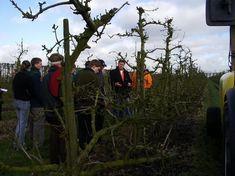
Edwin de Wit of major supplier Van Doorn International Fruit bv and Ton Besseling of agro-chemical manufacturer Makhteshim Agan introduced U40s Conference delegates to Van Doorn’s latest venture in pear production, ‘PearFect’.
The new method is the result of five years of experimenting to minimise the input of pesticides and create residue-free fruit, said Besseling.
“The participants of PearFect recognise the need for a modern certified crop programme that delivers consistent good quality fruit with the guarantee of safety, the evidence of a clear commitment to principles of sustainable agriculture, integrated farming practices and trust,” de Wit added.
The programme has been developed at the pilot farm of René Hoogland, one of Van Doorn’s key growers.
“With PearFect, chemicals have been replaced by mechanical growth regulation. And dose rates are adapted to suit the tree volume and leaf sizes several times during the season, to ensure the use of products is optimised and the environment is less burdened,” Besseling said.
To control growth, the tree stems are pruned like Bonsai. An incision is made on either side to allow concentration of growth in the fruit areas, restricting height.
While orchards used to be planted in single systems, producing around 2,000 trees per hectare, now, in 30 per cent of orchards, a V-system is used, while another 30 per cent adopt the table system.
The table system was used more widely 10 years ago but growers at Van Doorn have decided to revive it, since it can accommodate more than 10,000 trees per hectare and allows the trees to receive more light, which enables better fruit production.
De Wit explained that due to climatic conditions in the Netherlands it is not possible to produce enough class I fruit by simply growing organically.
But government restrictions, and demands from supermarkets for residue-free fruit are driving companies like Van Doorn to introduce more non-chemical methods of pest control.
“The PearFect project aims to set a new high standard for growing premium quality pears and to secure a sound business in the future. PearFect is based on scientific research and a high level of practical and technical experience,” said de Wit
An example of Van Doorn’s biological methods is the application of earwigs and the retention of weeds and herbs around the trees to reduce pear sucker.
Hoogland explained that he has also invested in new spraying equipment to ensure spraying is more evenly distributed and therefore used more economically.
With little development in pears in recent years, compared to apples, the market has been crying out for new varieties, said de Wit.
However, Van Doorn has launched two new pears, a red comice called Sweet Sensation and another variety, temporarily known as ‘Ugly’, which is similar to the Taylor’s Gold variety, but has a more aromatic taste.
After four years of cultivation, Van Doorn first introduced Sweet Sensation to the UK in 2003 for Sainsbury’s, and the company is planning to implement increased production of both varieties next year.
“There is not a lot of variation in pears but Sweet Sensation will break the green colour line on the shelves,” said de Wit. “And there is a big demand for red pears because they are very sweet. We have already introduced a small amount for trials in Sainsbury’s which have been very successful.”
Given its high brix levels, Van Doorn is considering naming the ugly fruit after the English sweet, pear drops, which it hopes will provide a unique selling point.
At one of its packing sites near Fijnaart, Van Doorn packs fruit for a number of customers at once, using its Aweta grading technology.
Like most packhouses in the Netherlands, it is not very large but de Wit says this provides the advantage of allowing rapid changeovers on the production line, for example, from conference to comice within a couple of minutes.
After grading, the best quality fruit will be sent to a number of retailers in the UK while the small sizes and class II fruit are marketed in Scandinavia, Spain and Russia, said de Wit.






No comments yet